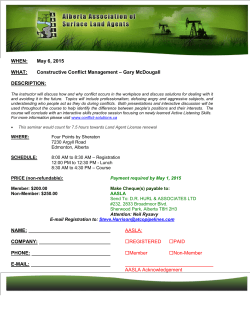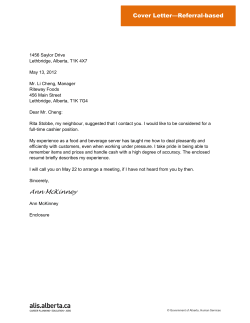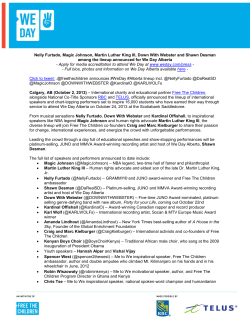
Assessment For Learning in Physical Education
Assessment For Learning in Physical Education Developed by Schools Come Alive in collaboration with the Alberta Regional Professional Development Consortium and the Alberta Assessment Consortium as a result of a grant from Alberta Education, Fall 2007 Workshop Goals Review the intent of the Physical Education Program of Studies Relate assessment for learning practices to student learning in Physical Education Examine assessment strategies and articulate assessment criteria Identify opportunities to access ongoing support and resources Making Dates What’s Happening Now? List the assessment tasks and topics that you typically use to generate a report card grade for students in physical education Snowball time! What’s Happening Now? Tally the data in your group What does assessment in physical education ‘look like’? Is this landscape helping students to learn and achieve? Activity Benefits Health Cooperation Do It Daily… For Life Physical Education in Alberta Why Does the “Front Matter” Matter? Because students need to… Then as a teacher, I need to… Acquire skills through , a variety of developmentally appropriate movement activities; dance, games, types of gymnastics, individual activities and activities in an alternative environment Assessment… Speaking the Language of Assessment A - Descriptive feedback B - Learner outcomes C - Self-reflection D - Assessment E - Performance assessment F - Assessment for learning G - Assessment of learning H - Performance I - Evaluation J - Criteria Assessment Purposes Work with your team Sort the wordstrips into two columns: Assessment FOR Learning Assessment OF Learning Based on the work of Ruth Sutton Source: AAC Refocus, 2nd Edition, 2005 Assessment For Learning The research says… Students taught by teachers who used assessment for learning achieved in six or seven months what would otherwise have taken a year. Assessment for learning practices raises the achievement level of students, particularly those of low achievers. Black & Wiliam, 1998 Assessment For Learning 5 Key Strategies: Share outcomes and criteria with students prior to the learning activities Use effective questioning Provide descriptive feedback Increase student ownership Encourage peer coaching Black & Wiliam, 1998 Yeah, but… All of this talk about assessment for learning is good, but… What questions do you have? What are the challenges to implementing assessment for learning practices in physical education? Identifying Curricular Priorities ROCKS SAND Enduring outcomes (high priority outcomes most closely related to the aim and rationale of the program assessment of learning) Important to know and do WATER (knowledge/skills more directly related to enduring outcomes assessment for learning) Worth being familiar with (knowledge and skills needed first, to successfully achieve the enduring outcomes assessment for learning) Identifying Curricular Priorities What are the rocks, sand and water in Physical Education? Grade level group discussion Assessment For Learning 5 Key Strategies: Share outcomes and criteria with students prior to the learning activities Use effective questioning Provide descriptive feedback Increase student ownership Encourage peer coaching Black & Wiliam, 1998 A Closer Look at Criteria C(K-30)-3: students will demonstrate etiquette and fairplay What would it look like if students were achieving the outcome? Pull the action words out of the outcome – what do students need to do? Shared Assessment Experiences How can we work with the questions and concerns about assessment for learning in the interest of improved student learning? Open space discussions… Making Decisions About Assessment Materials Refer to the template on page 11 of the participant handout when reviewing your own assessment tools, or those from other sources. The Journey Continues… What might assessment in physical education look like when we consider the role of assessment for learning?
© Copyright 2025





















